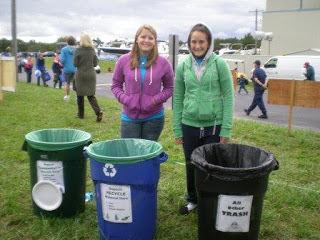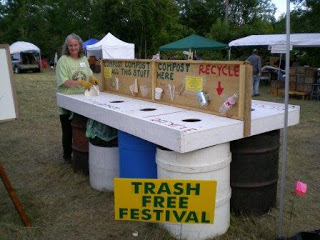April 9, 2013
The next installment on special event composting includes setting up the "compost team" and event publicity, along with examples of special event composting in action.
The compost team
An essential key to successful composting is active monitoring of the green stations.
One monitor per station ensures that:
- Attendees are educated, not frustrated!
- Contamination of collected materials is reduced.
- The need to sort through collected materials is eliminated.
Compost coordinator duties include:
- Set-up (containers in place, signage, etc.).
- Train, assist, and relieve station monitors.
- Oversee removal of full bags or carts to the service area.
- Vendor training and monitoring; and
- Troubleshooting.
The compost coordinator must provide station monitors with an overview of what is compostable and what isn't, as well as composting/recycling logistics, and safety (lifting, not sticking hands directly into containers, etc.). Monitor duties include: providing a brief "compost talk" to event attendees and helping them sort materials; notifying the coordinator when bins need emptying; and, keeping the stations clean. Most event attendees will be unfamiliar with compostable plastics, so it is important that monitors let them know that the items are made from corn (or potato starch, bamboo, etc.), and that yes, they are compostable at a commercial operation.
Larger events may want to assign "floaters" to help in emptying containers and moving full bags or carts to the staging or service area.
Clean-up is busy and volunteers need to be pre-assigned to help remove collection bags/carts to the service area or leave in designated locations for hauler pick-up; set-up for the next day (if the event continues) or breakdown stations if the event is over; and pick-up litter.
Publicity
Just as with recycling, promotion is effective at both helping to educate attendees and also gaining recognition for the event's greening efforts. Use the event website and social media, press releases, fliers/posters, green station locations on maps, and stage announcements to get the word out.
Examples of Compost Success
SolarFest, Tinmouth, Vermont
Approximately 9,000 people attend this three-day event which features workshops, exhibitors, children's activities, and entertainment.
 NERC worked with event organizers to develop a "food waste management plan," outlining the necessary tasks for successful adoption of composting.
NERC worked with event organizers to develop a "food waste management plan," outlining the necessary tasks for successful adoption of composting.
Organizers required food vendors to use compostable service ware. NERC provided vendor outreach information, volunteer training materials, and promotional suggestions, along with onsite technical assistance during the 2009 event to assist in setting up the "zero waste" stations, training monitors, assisting in monitoring the stations, and troubleshooting.
An estimated 1,400 pounds of food waste, soiled paper, and compostable service ware was collected for composting, along with 780 pounds of recyclables during the 2009 event. Trash cans were limited to the portable toilet areas. Compostable materials were hauled by the Rutland County Solid Waste District staff to their compost site. The event continues to be zero waste.
Coast Day, Lewes, Delaware
Coast Day is hosted by the University of Delaware, College of Earth, Ocean, and Environment and the Delaware Sea Grant College Program. Attendance is usually around 10,000 for this popular event, which features chowder tasting contests, cook-offs, and exhibits. Event organizers worked with NERC staff in 2011 to implement composting.

Five "green stations" were set-up around the main food vendor area and the cook-off tents. High school students and University Green Team members monitored the stations throughout the day. Full bags of compost, recyclables, and trash were collected by University crew; compostables were hauled to Blue Hen Compost Facility for processing.
The event continues to provide both composting and recycling opportunities.
Garlic and Arts Festival, Orange, Massachusetts
 Some 10,000 people attend this two-day event to enjoy entertainment, hundreds of booths, workshops, and more. The Festival has been a zero waste event for seven years. The author volunteered with event organizers to implement composting nine years ago and continues to help coordinate zero waste activities.
Some 10,000 people attend this two-day event to enjoy entertainment, hundreds of booths, workshops, and more. The Festival has been a zero waste event for seven years. The author volunteered with event organizers to implement composting nine years ago and continues to help coordinate zero waste activities.
Vendors are required to only use compostable service ware. Volunteers staff five zero waste stations throughout the event. The stations are two color—green for compost and yellow for recycling, with circular holes through which materials are tossed into lined barrels (compostable bags for compost; clear bags for recyclables). Visible, eye-level signage is connected to the bins, with sample service ware products integrated into the design.
Typically more than 120 bags of compostable material are collected from the event, weighing around a ton. Numerous bags of recyclables are also collected, with only 2-3 bags of trash (from the portable toilet area).



Comments (0)
Add a Comment